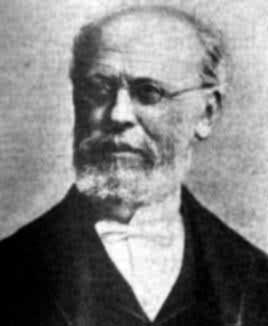


 تاريخ الرياضيات
تاريخ الرياضيات
 الرياضيات في الحضارات المختلفة
الرياضيات في الحضارات المختلفة 
 الرياضيات المتقطعة
الرياضيات المتقطعة
 الجبر
الجبر
 الهندسة
الهندسة 
 المعادلات التفاضلية و التكاملية
المعادلات التفاضلية و التكاملية 
 التحليل
التحليل
 علماء الرياضيات
علماء الرياضيات |
Read More
Date: 13-11-2016
Date: 12-11-2016
Date: 13-11-2016
|
Died: 9 April 1920 in Heidelberg, Germany

Moritz Cantor entered Heidelberg University in 1848, then worked under Gauss, Weber and Stern at Göttingen. He returned to Heidelberg where he presented his doctoral thesis in 1851. He then studied at Berlin with Dirichlet and Steiner. In 1853 he was appointed tutor at the University of Heidelberg and he was to remain at Heidelberg all his life.
Cantor's early work was not on the history of mathematics but he did write a short paper on Ramus, Stifel and Cardan which he presented to a scientific meeting in Bonn. Later Cantor told Cajori, see [4], that his paper was
so well received that he felt encouraged to continue his historical work.
During a visit to Paris, which Cantor made shortly after his encouraging Bonn meeting, he became friendly with Chasles and Bertrand. Chasles was an acknowledged leading expert on the history of geometry and encouraged Cantor to publish further historical material in Comptes Rendus.
From 1860 Cantor lectured on the history of mathematics and became one of the leading German historians of mathematics at the end of the 19th Century. His first significant work was Mathematische Beiträge zum Kulturleben der Völker (1863) (Mathematical Contributions to the Cultural Life of the People).
Not only did 1863 mark the first important work by Cantor, but it also was the year in which he was promoted to extraordinary professor at Heidelberg.
Cantor is best remembered for the four volume work Vorlesungen über Geschichte der Mathematik which traces the history of mathematics up to 1799. The first volume was published in 1880 and the last volume appeared in 1908.
The first volume traces the general history of mathematics up to 1200. The second volume traces the history up to 1668. The year 1668 was chosen by Cantor because in this year Newton and Leibniz were just about to embark on their mathematical researches. The third volume continues the overview of the history up to 1758, again chosen because of the significance of Lagrange's work which began shortly after this date.
After completing the third volume Cantor realised that, at the age of 69, he was not up to the task of completing another volume, so at the Congress of 1904 in Heidelberg he organised a team with nine further contributors to collaborate on the fourth volume. As editor-in-chief Cantor set high standards and insisted that the style and impartiality of the first three volumes be retained. This fourth volume again stopped just before a highly significant development since 1799 is the year of Gauss's doctoral thesis.
Cajori describes in [4] meeting Cantor, then 86, in 1915. Cantor described himself as
... a hewer of timber who with a big axe and with powerful strokes roughly cut the timber to proper form and dimension, but left it for those who follow him to dress, polish and finish.
Cantor was an excellent linguist and Cajori describes in [4] some amusing incidents of English speaking mathematicians speaking foreign languages at Congresses told to him by Cantor.
Moritz Cantor was no relation to Georg Cantor who referred to him as his Namensvetter (cousin by name only).
Articles:



|
|
|
|
دراسة تحدد أفضل 4 وجبات صحية.. وأخطرها
|
|
|
|
|
|
|
جامعة الكفيل تحتفي بذكرى ولادة الإمام محمد الجواد (عليه السلام)
|
|
|